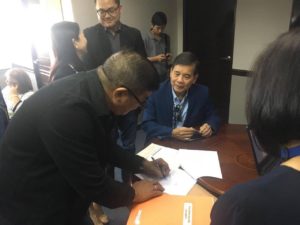The Japanese government plans to use about ¥1 trillion in financial support through joint public-private sector projects for emerging economies that import liquefied natural gas, according to sources.
The Japanese government has made expanding exports of “high-quality infrastructure” one of its economic growth strategies. The government expects gaining U.S. support in this field will increase the number of overseas orders placed with Japanese companies.
Hammering out cooperation in the energy field is also aimed at deflecting the displeasure of President Donald Trump’s administration over Washington’s trade deficit with Tokyo.
The Trump administration, which has set about reducing U.S. trade deficits, would gain Japanese cooperation in opening up new markets for exports of its shale gas, which is natural gas trapped in rocks.
The United States exported about 409.9 billion cubic feet (about 11.6 billion kiloliters) of liquefied natural gas between January and August 2017 — about double the volume exported during all of 2016. However, most of these exports went to Mexico, and there are limited prospects for sending LNG to developing economies where energy demand is forecast to grow. Even if the United States attempted to boost these exports, delays in establishing facilities such as installations that can handle LNG in emerging economies would hamper any such plan.
The memorandum states the Japanese side will tap private-public cooperation to establish LNG-related facilities and other plants in emerging economies that will lead to increased U.S. exports. Such infrastructure likely will include the construction of pipelines that carry gas and highly efficient thermal power plants that use LNG — fields in which Japan excels.
Last month, the Japanese government announced a plan to offer ¥1 trillion in support in joint public-private projects to build LNG storage and other facilities in Asian nations that produce and consume LNG. The government wants to use these funds to implement the U.S. initiative. India and several nations in Southeast Asia have been floated as candidates for new facilities.
The Japanese and U.S. governments will also share information on investment matters and strengthen cooperation in the financial field, including necessary business loans for companies that export infrastructure to emerging economies, and insurance to cover losses that may arise.


